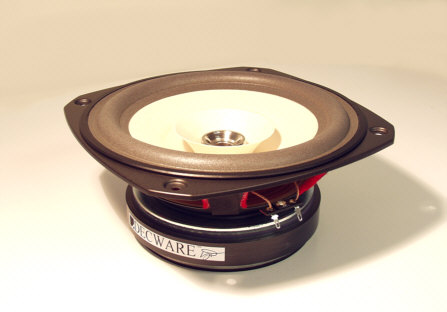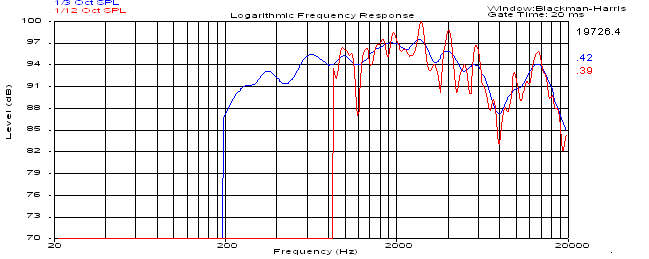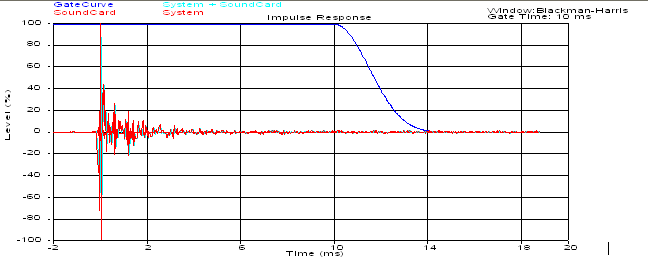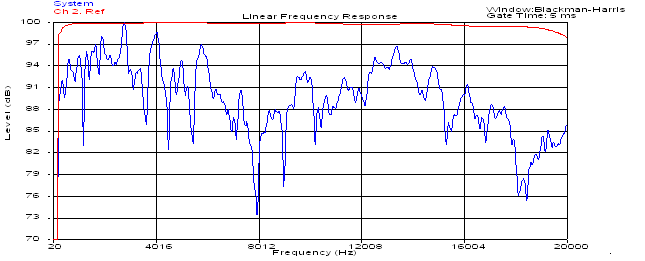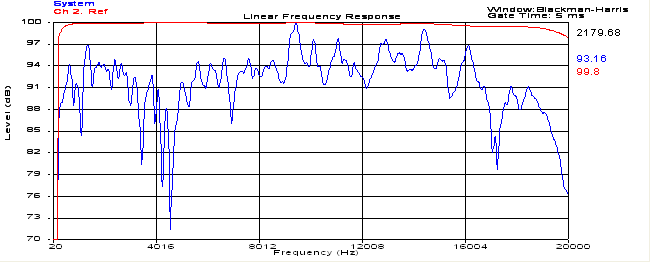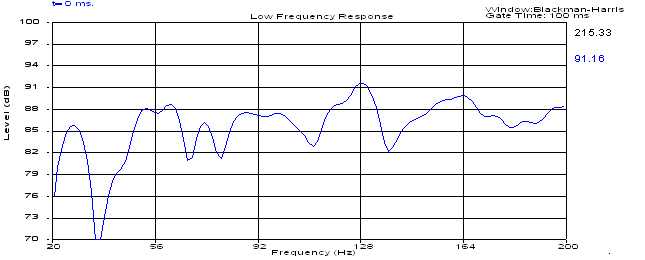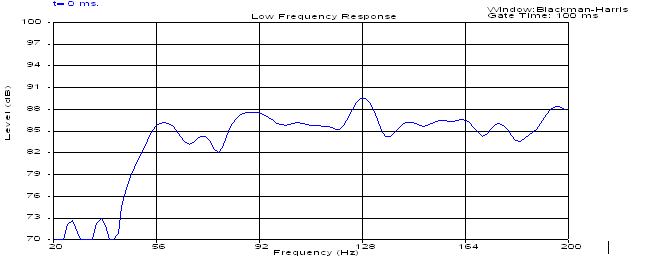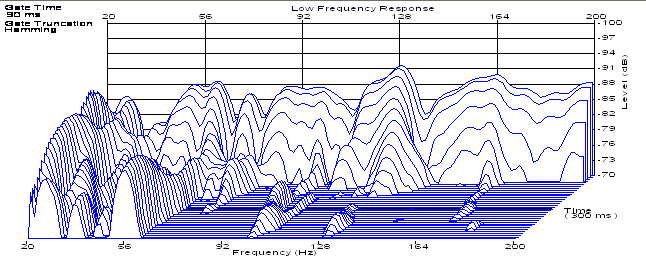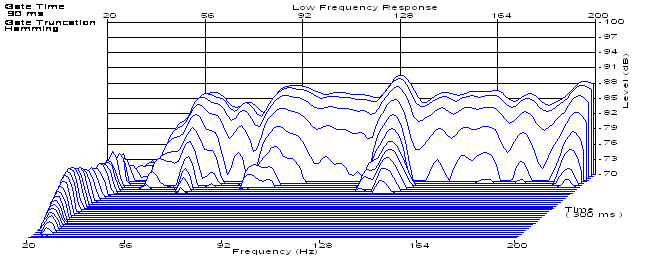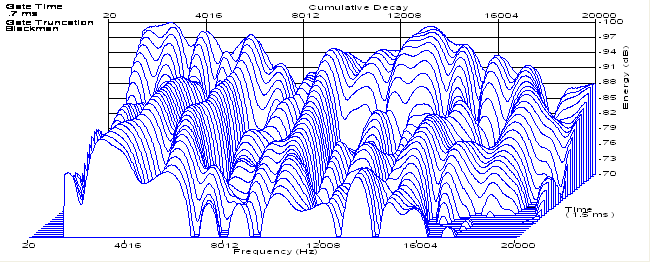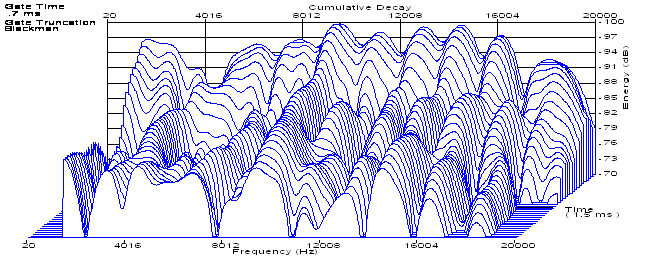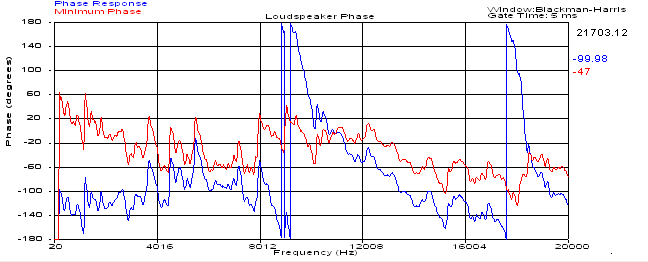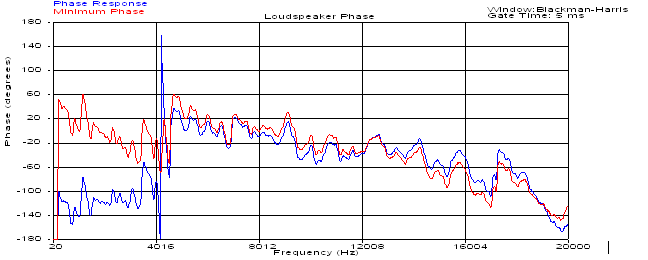|
DECWARE
FULL RANGE DRIVER Mar 2006 Introduction We
started offering our modified Fostex FE206EM
drivers (shown below) to the D.I.Y. market several years ago with
the most popular cabinet design being the HDT.
If you're new to these types of drivers, they all share a few common denominators. A) they are efficient, B) They are extremely fast, C) Bass is not their passion, or put another way is something that has to be earned with a good cabinet design. D) Midrange presence is always above average. E) Perhaps most importantly is the cones are paper thin. Let's touch on E for a second. Paper thin cones are super low mass, and that is a good thing making A, B, C and D what they are. The down side is that any sound on the back side of the cone is easily transmitted to the front side of the cone. Quick example: Remove driver from enclosure. Toss an AM battery operated radio inside the cabinet. Reinstall the driver. The AM battery radio will be crystal clear and actually be louder than when it was outside of the cabinet in your hands. This is the main reason why so many single driver speaker designs have certain issues that often get labeled as midrange shout. In summary,
the original FE206E was a decent driver. Our modified version
of it, the FE206EM was a significant improvement made possible by
a number of changes. We have found other ways to improve it, and
after a year of testing are now ready to release what will likely
be the final version, the DFR-8 (Decware Full Range - 8 inch).
This paper will define the improvements between the FE206EM and the new DFR-8 shown above. Active phase guide Besides damping
the frame and some minor cone treatments, the biggest modification
to the original Fostex driver was the phase
guide that was installed in place of the dust cap. The actual
shape of this active phase guide is something that I've been playing
with over the past year by having various designed machined and
then installing them into the prototypes that we listen
to every week. Of course we also applied these guides to other
full range drivers such as the audio nirvana 8 inch and the less
expensive Lowthers. I bring that up because the lesson that
came out of it is that every phase plug or in our case the
active phase guide must be unique for the driver it is used
in. The picture above is where the phase guide design landed. This final version has a shorter port which raises the resonant frequency. That makes the guide more active in the top two octaves. This new phase guide was used in some of the final FE206EM drivers that were made, and is standard in the new DFR-8. The DFR-8 takes all of the mod's of the FE206EM to a more refined level (including cone treatment) but with a new suspension design that is also active. If we can animate the function of a phase plug why not some of the rest of the speaker? The new suspension design creates a diaphragmatic absorber that sucks nearly all of the modal resonance's out of the cone and coverts that unwanted energy into heat.
The DFR-8 active suspension system The original FE206EM used an inverted roll cloth surround that is attached to the under side of the speaker cone. The cloth is treated, but not air tight making it impossible to create a truly sealed diaphragm between the inside and outside of the speaker cabinet. The cloth has the advantage of being low mass, strong, and quick. It offers no damping like butyl rubber but then butyl rubber is high mass, less strong, and slow. If you look at Lowther speakers they typically use polyether foam, not unlike that found in many hi-fi speakers. I suspect the reason why is because the polyether foam is the most responsive, or fastest of all the available surround materials. We have added a specially matched positive roll polyether foam surround to the top of the cone, while leaving the existing inverted cloth surround in-tact. This creates a more linear resistance on the cone in both directions. It also by nature adds some damping to the cone, another reason Lowther probably uses it. But in the case of this driver, having both creates a dead air space that is sealed (but with a high Q loss from the original cloth to the inside of the enclosure) that effectively becomes a perfect absorber for the midrange frequencies that are most effected by modal resonance's and reflected energy inside the cabinet. I call it a diaphragmatic donut. The moving mass and FS are not notably effected by this new suspension system but the linearity has improved significantly. Having such a high tech push-pull suspension keeps the voice coil in the gap a greater percentage of the time which actually increases the efficiency in the areas where it suffered from 5K on up. The suspension system also offers tighter bass control and enhances low frequency power handling by a notable amount. In an open baffle situation it makes it possible to run the driver full range below the cut off of the baffle step without it unloading on low frequencies nearly as quick. In cabinets, the suspension eliminates low frequency rumble at 20 Hz, and gives the bass that IS there some real weight and percussion. The positive roll also increases the actual surface area of the cone making the speaker diameter larger than before and also seems to give a better off axis launch from the outer diameter of the speaker cone. (Better imaging)
Measurement of the FE206EM and DFR-8. To try and find a way to accurately show the differences between FE206EM and the new DFR-8 I had to really think about it for awhile... The anechoic frequency response supplied by Fostex for the stock FE206E would be the first place to start, and then compare it with the new DFR-8. Problem is, these frequency response plots really tell you nothing. Your probably better off when selecting a driver if you don't even look at them. The weighting and scales used can modify the response graph to look more attractive on paper than it really is. When you combine that with the reality that it will measure nothing like this in your cabinet or room you have to take manufactures frequency response charts with a grain of salt. Anechoic response graphs published for a given driver do not tell you how the speaker will sound, or what the actual frequency response will be. There could be a narrow peak at 3kHz that simply doesn't show up on the graph. It could be one that you would find distracting or even annoying to the point of not liking the speaker. In the listening room the drivers response and other characteristics are greatly effected by what happens on either side of the speaker cone. Interactions from the cabinet will effect the back side while interactions with the listening space will effect the front side of the speaker cone and thereby modify it's response. The speaker itself reacts with the amplifier driving it which further modifies the speakers response. Add to that the fact that from spot to spot throughout your entire listening space, no two spots will measure the same and it's easy to see why a factory response chart is almost useless. Example: If
you look at the graph below you will see a logarithmic frequency
response chart done in two different scales. The 1/3 octave
is the blue line and is what you usually see from the speaker
manufactures. The red line is a more sensitive 1/12 octave
plot that begins to reveal the narrow peeks and valleys that make
up a speakers frequency response. You can see that the blue
line is easier to interpret than the red, but the red has far more
information in it.
How we measured it Ultimately to answer the anticipated question; "What's the difference between the FE206EM and the newer DFR-8" we choose to install the drivers into a pair of ideal cabinets placed into an average sized listening space. With computers we can now measure the individual wave fronts coming off the cone before room reflections modify those wave fronts. By gating the response to just a few milliseconds it is possible to see what would be similar to the anechoic response of the speaker while at the same time study the decay from room reflections. This approach gives us more usable data in regards to how something might sound when it gets put into use in the real world. To find the best mic placement for testing a real time measurement was taken showing a 3D waterfall plot that we could watch change as we moved the mic around. The idea is to gradually move the mike until you find the smoothest response. This ended up being around 15~20 degrees off axis on both speakers. Since mic placement can wildly change the frequency response you'll measure, it is imperative that both speakers are measured from the same point in space. Also the distance
for the mic was 11 inches from the cone. The mic used is calibrated
as is the sound card in the computer doing the measurements. For
these tests the amplifier used was the SE34I.2
which is a class A single ended triode at 6 watts per channel. Impulse response The first measurement is a burst test that shows the impulse response of the two drivers. It gives us a general idea of the speed at which the driver will start and stop, however since the burst test is not using music, it doesn't tell us how well the driver will maintain this impulse response as the volume is increased while listening to music. In listening tests it was easy to hear the new suspension system deal with low frequency information in a far better way than the FE206EM, yet it is only hinted at in the graphs below.
The graph above is the impulse response of the FE206EM. The cone has stopped moving within 2 milliseconds. Below is the DFR-8. The cone has stopped moving within 1.5 ms and the initial burst is cleaner. Both of these are killer good compared to a conventional hi-fi woofer but between the two, the DFR-8 comes out on top.
Linear frequency response The graph below is the FE206EM. On a response chart like this we are especially interested in the area between 20Hz and 4016Hz. This is where the bulk of the music lives and the critical midrange where our ears are most sensitive. Key points in this response are the narrow 6dB peek at 3kHz and the large trough at 8Khz and the roll off starting around 14kHz.
Low frequency response The first graph below is the FE206EM. Of interest is the apparent flutter centered at 28 Hz. This also showed up on the stock FE206E drivers. Remember the driver is suppose to roll at 40Hz.
Here are the same two graphs in a water fall plot showing the decays. The first one is for the FE206EM and the second one under it is for the DFR-8.
An impressive improvement can be seen below with the new DFR-8.
Full range cumulative decays And here are the wide range waterfall plots of each driver. These will match the linear frequency responses shown earlier on this page. The first is the FE206EM followed by the DFR-8.
A final point of interest is the phase response of each driver. In this graph you are looking for the blue line to follow the red reference line as closely as possible. The first chart is for the FE206EM, the second is for the DFR-8.
Once again, the graph below shows the DFR-8 with a significant improvement in the phase response
Cone treatments The black dye originally used on the FE206EM is no longer used on the DFR-8. The process leaves the natural color of the banana fiber. We use a polyacrylic diluted with water and apply it to the cone under a high rotation. As the cone gets wet the fibers expand and the top layer of fibers are re-animated and brushed in the direction of the rotation. When the moisture evaporates from the cone, the polyacrylic encapsulated fibers are locked into position. The reason we do this is to remove the stress locked into the paper cone when it is pressed. The untreated cone is glass smooth to the touch while the treated cone has lost the gloss and developed a subtle texture. The improvement you hear in the sound of the paper itself when rubbed also shows up in the timbre of instruments and voices. A final benefit this cone mod brings is a stronger cone and one that is less effected by changing humidity.
Other tweaks The basket has felt lined spokes behind the cone, and each spoke is also dampened on the outside with viceoelastic foam pads. There is also a small 1/2 inch square pad added to the back side of the cone opposite the lead wires to offset the mass of the lead wires and damp ringing from the neck joint.
Listening tests When you listen to a 1kHZ reference sine wave on the FE206EM it sounds like any other decent driver would, but when you listen to a 1kHz sine on the DFR-8, it actually has tone, sounding more like an instrument than an oscillator. This was a rare observation made during testing. In the listening room, the driver is far smoother with noticeably better top end. The focus is better, and the sound projects better as opposed to sounding like some of the sound is coming out of the speaker cabinet itself. The ability of the cabinet to disappear has greatly improved. If was to rate each driver between 1 and 15, I would give the stock FE206E a 7.0, our modified FE206EM a 8.3 and the DFR-8 a 11.5 in over all sound quality just to give you an idea of the range of improvement. For anyone with the original FE206EM drivers wishing to have the new suspension system added, you can contact me or just send the drivers in with a letter stating what you want done. Cost of the upgrade would run around $25 for each driver. Upgrading the phase guide is usually not possible, however an original FE206EM with the newer suspension will sound very close to the DFR-8, with a sound quality of 10.5 based on the example above.
Decware is a trademark of High Fidelity Engineering
Co. |
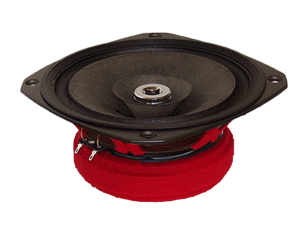 During
this span I don't think a week went by where we didn't listen to
these drivers - and on an ever changing variety of amplifiers.
At the same time we also swap in and out a rather large variety
of other fine speaker designs that don't employ the single driver
approach. This has given us a well earned perspective on the
strengths and weakness of our FE206EM driver. The FE206EM
was a significant step up from the stock Fostex FE206E and offered
a slightly smoother frequency response and better high frequency
response (something that the stock driver sorely lacked).
During
this span I don't think a week went by where we didn't listen to
these drivers - and on an ever changing variety of amplifiers.
At the same time we also swap in and out a rather large variety
of other fine speaker designs that don't employ the single driver
approach. This has given us a well earned perspective on the
strengths and weakness of our FE206EM driver. The FE206EM
was a significant step up from the stock Fostex FE206E and offered
a slightly smoother frequency response and better high frequency
response (something that the stock driver sorely lacked).